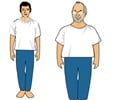A global study has revealed that close to half of the general population is overweight, revealing that ‘excess body weight is pandemic’.
A global study has revealed that close to half of the general population is overweight, revealing that ‘excess body weight is pandemic’.
The study found that 40 percent of men and 30 percent of women are overweight, while 24 percent of men and 27 percent of women are obese. “This is the largest study to assess the frequency of adiposity (body fat) in the clinic, providing a snapshot of patients worldwide," said study lead author Beverley Balkau, Ph.D., director of research at INSERM in Villejuif, France. (INSERM is the French equivalent of the U.S. National Institutes of Health.)."The study results show that excess body weight is pandemic, with one-half to two-thirds of the overall study population being overweight or obese. “Central adiposity adds significantly to the risk of developing heart disease and particularly of developing diabetes,” Balkau said.
Physicians recorded age, gender, presence of heart disease or diabetes and measured waist circumference (WC), with a tape measure placed midway between the lower ribs and the iliac crest of the hips. Weight and height were measured and body mass index (BMI) was calculated. "WC is a more powerful clinical marker of heart disease and diabetes than BMI. Visceral fat is an important determinant of cardiovascular disease and diabetes, and the WC is closely related with visceral fat as evaluated by CT scans. The WC is so easy to measure in the clinic,” Balkau said.
Being overweight or obese has health consequences, but abdominal obesity has even worse consequences, she added. As measured by WC using International Diabetes Federation Caucasian criteria, more than half the study population - 56 percent of men and 71 percent of women - had abdominal adiposity (WC 37 inches (94 cm) in men and 31.5 inches (80 cm) in women).
"Overall there's a significant increase in the frequency of heart disease and diabetes with increasing waist circumference," Balkau said. "For men, each increase of approximately 5.5 inches (14 centimetres) means an increased frequency of about 35 percent for heart disease and for women an increase of approximately six inches (15 centimetres) equates to a 40 percent increase for heart disease. Even in people who are lean, an increasing waist circumference means increasing risk for heart disease and diabetes,” Blaku added.
As measured by BMI, more than 60 percent of men and 50 percent of women were either overweight or obese, with a BMI of 25 kg/m2 or more. The overall frequency of overweight was 40 percent in men and 30 percent in women, with similar frequency across geographical regions. The frequency of obesity, a BMI of 30 kg/m2 or more, differed between regions and ranged from a low of 7 percent in both men and women in South and East Asia, to 36 percent in Canadian men and women.
Advertisement
The frequency of diabetes varied more across regions than CVD. Overall, 13 percent of men and 11 percent of women were diagnosed with diabetes. Both diabetes and heart disease were more common in men than women. Balkau called upon governments to take more preventive measures to stem the tide of obesity and overweight, such as providing more access to physical activity and encouraging people to exercise.
Advertisement
The study is published in Circulation: Journal of the American Heart Association.
Source-ANI
LIN/C






